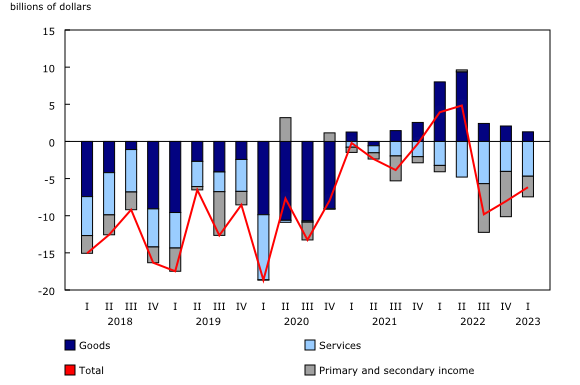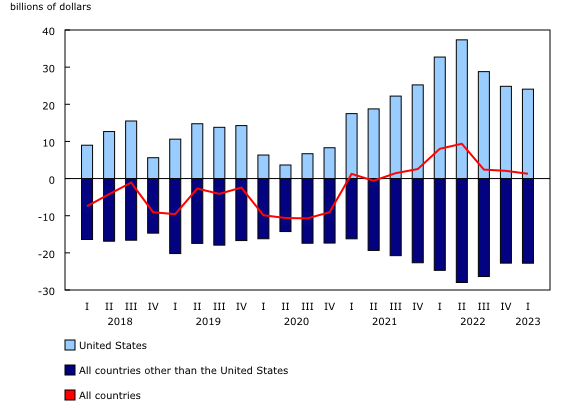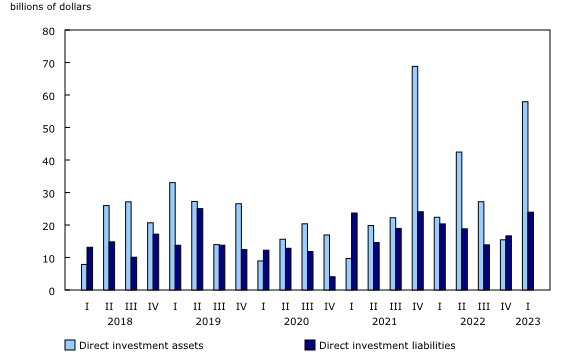Canada's balance of international payments, first quarter 2023
Released: 2023-05-30
-$6.2 billion
First quarter 2023
Canada's current account deficit (on a seasonally adjusted basis) narrowed by $1.9 billion to $6.2 billion in the first quarter. The lower deficit mainly reflected a smaller investment income deficit, partially offset by a higher trade in goods and services deficit.
In the financial account (unadjusted for seasonal variation), inflows of funds from abroad to finance the current account deficit came primarily from a reduction in foreign portfolio shares and loans as well as from new issuances of corporate bonds on international markets. Meanwhile, the direct investment activity generated a net outflow of funds totalling $34.0 billion as direct investment abroad surged in the quarter.
Current account
Higher trade in goods and services deficit
The trade in goods and services balance posted a $3.4 billion deficit in the first quarter of 2023, up $1.4 billion from the fourth quarter of 2022. Overall imports increased while exports were down during the first quarter of 2023.
Exports of goods were down by $1.0 billion to $193.7 billion in the first quarter. Exports of energy products fell $6.1 billion as prices continued their downward trend, while exports of motor vehicles and parts increased by $3.3 billion. Meanwhile, imports of goods edged down by $0.2 billion to $192.4 billion.
The trade in services deficit expanded by $0.6 billion to $4.7 billion in the first quarter. The travel deficit rose by $0.5 billion. Expenses by Canadians travelling abroad continued to increase, up by $0.8 billion. These expenses have more than doubled since the first quarter of 2022.
The transport services deficit increased by $0.2 billion in the first quarter of 2023, as exports were down. Imports were unchanged from the previous quarter and reflected higher payments related to the transport of passengers by air, offset by lower payments for the transport of merchandise by water.
Lower deficit for investment income
The investment income deficit narrowed by $2.6 billion to $0.9 billion in the first quarter. Profits earned by Canadian direct investors abroad rose by $2.5 billion, while those earned by foreign direct investors in Canada were up $1.9 billion compared with the fourth quarter.
Income generated on loans and deposits continued to increase in the wake of rising global interest rates, with receipts up by more than payments in the first quarter of 2023. Interest received on foreign loans and deposits has increased more than five-fold in the last year. During the same period, interest paid on such instruments held by non-residents in Canada almost tripled.
Financial account
Canadian investors sell foreign shares
In the first quarter, Canadian investors reduced their exposure to foreign securities by $23.4 billion, the first quarterly divestment in a year. Investors largely sold US shares and, to a lesser extent, non-US foreign shares in the quarter. The overall divestment was moderated by the acquisition of $3.2 billion in foreign bonds.
On the other side of the ledger, foreign investors reduced their exposure to Canadian securities by $8.0 billion in the first quarter. Divestments in shares (-$16.6 billion) and money market instruments (-$16.4 billion) were moderated by foreign investments in Canadian bonds (+$24.9 billion), mainly new corporate bonds denominated in non-US foreign currencies.
Canadian direct investment abroad surges
Canadian direct investment abroad reached $57.9 billion in the first quarter, more than the previous two quarters combined. Cross-border mergers and acquisitions of $37.9 billion, the highest level since the fourth quarter of 2021, led the investment activity. On a sector basis, more than half of the overall direct investment abroad was in the finance and insurance sector. On a country basis, the investment was predominantly directed to the United States.
Foreign direct investment in Canada totalled $23.9 billion in the first quarter of 2023, up from $16.7 billion in the previous quarter. While earnings reinvested in Canadian affiliates by their foreign parents remained elevated, cross-border merger and acquisition activity totalling $9.2 billion also contributed to the overall investment.
Note to readers
Upcoming changes within the Balance of payments program
In the fall of 2023, Statistics Canada will be updating the North American Product Classification System (NAPCS) used for goods import and export statistics. The NAPCS 2022 version will replace NAPCS 2017, which is the version currently in use.
This change will be reflected in the third quarter statistics for the Balance of International Payments which is scheduled to be published in November 2023.
Definitions
The balance of international payments covers all economic transactions between Canadian residents and non-residents in three accounts: the current account, the capital account and the financial account.
The current account covers transactions in goods, services, compensation of employees, investment income and secondary income (current transfers).
The current account data in this release are seasonally adjusted. For information on seasonal adjustment, see Seasonally adjusted data—Frequently asked questions.
The capital account covers capital transfers and transactions in non-produced, non-financial assets.
The financial account covers transactions in financial assets and liabilities.
In principle, a net lending (+) or net borrowing (-) derived from the sum of the current and capital accounts corresponds to a net lending (+) or net borrowing (-) derived from the financial account. In practice, as data are compiled from multiple sources, this is rarely the case and gives rise to measurement error. The discrepancy (net errors and omissions) is the unobserved net inflow or outflow.
Foreign direct investment is presented on an asset-liability principle basis (that is, gross basis) in the financial account. Foreign direct investment can also be presented on a directional principle basis (that is, net basis), as shown in supplementary foreign direct investment tables 36-10-0025-01, 36-10-0026-01, 36-10-0473-01 and 36-10-0656-01. The difference between the two foreign direct investment conceptual presentations resides in the classification of reverse investment such as (1) Canadian affiliates' claims on foreign parents and (2) Canadian parents' liabilities to foreign affiliates. Under the asset-liability presentation, (1) is classified as an asset and included in direct investment assets, also referred to as direct investment abroad in this text, and (2) is classified as a liability and included in direct investment liability, also referred to as direct investment in Canada in this text.
For more information on the balance of payments, consult "Chapter 8. International Accounts," in the User Guide: Canadian System of Macroeconomic Accounts, available on Statistics Canada's website. The chapter also presents the most recent balance of payments statistics.
Real-time table
Real-time table 36-10-0042-01 will be updated on June 5, 2023. For more information, see Real-time tables.
Next release
Balance of international payments data for the second quarter of 2023 will be released on August 31, 2023.
Products
The document, "Enterprise surveys and the measurement of digital trade in services in Canada," which is part of Latest Developments in the Canadian Economic Accounts (13-605-X), is now available.
The product Canada's international trade and investment country fact sheet (71-607-X) is available online. This product provides easy and centralized access to Canada's international trade and investment statistics, on a country-by-country basis. It contains annual information for nearly 250 trading partners in summary form, including charts, tables and a short analysis that can also be exported in PDF format.
The product "Canada and the World Statistics Hub" (13-609-X) is available online. This product illustrates the nature and extent of Canada's economic and financial relationship with the world using interactive graphs and tables. This product provides easy access to information on trade, investment, employment and travel between Canada and a number of countries, including the United States, the United Kingdom, Mexico, China and Japan.
The Economic accounts statistics and International trade statistics portals are available from the Subjects module of the Statistics Canada website.
The product Methodology for Exports of Energy Products within the International Merchandise Trade Program, which is part of Latest Developments in the Canadian Economic Accounts (13-605-X), is available.
The Methodological Guide: Canadian System of Macroeconomic Accounts (13-607-X) is available.
The User Guide: Canadian System of Macroeconomic Accounts (13-606-G) is also available.
Contact information
For more information, or to enquire about the concepts, methods or data quality of this release, contact us (toll-free 1-800-263-1136; 514-283-8300; infostats@statcan.gc.ca) or Media Relations (statcan.mediahotline-ligneinfomedias.statcan@statcan.gc.ca).
- Date modified:




